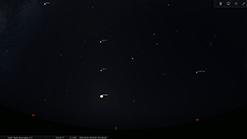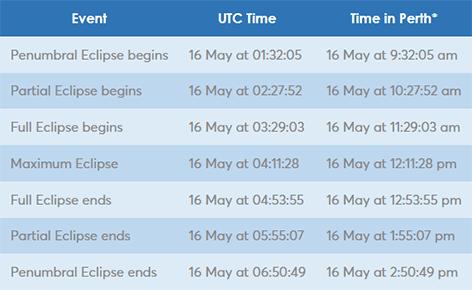
5 minute read
What’s In May’s Skies
By Matt Woods
Planets:
Advertisement
Mercury is still the only planet in the early evening, and it can be found very low in the West at the start of this month. it’s located in the constellation of Taurus (The Bull) but it disappears halfway through May. Venus can by observed in the constellation of Pisces (The Fish) for almost the entirety of May, before it moves into the constellation of Cetus (The Sea-Monster) at the very end of May.
Mars appears at the start of the month in the constellation of Aquarius (The Water-Bearer), and halfway through May it’ll move into the constellation of Pisces where it will end the month in a conjunction with Jupiter.
Jupiter can be in the constellation of Pisces throughout May between Mars and Venus, but Mars will move closer and closer to the point where Mars and Jupiter should be viewable together in a telescope eyepiece on Thursday the 30th of May. Saturn leads the alignment of the planets and can be found in the constellation of Capricornus (The Sea-Goat) throughout May. Uranus has returned out of the Sun’s glare in the early morning halfway through May. You’ll be able to find it in the constellation of Aries (The Ram). Neptune can be located above Mars and Jupiter in the constellation of Pisces for all of May.
The planets on the 15/05/21 at 5 am (AWST)
Alignments, Conjunctions, And Occultations:
Conjunctions involve object(s) in the Solar System and/or more distant objects, such as a star. It’s an apparent phenomenon in which multiple objects which aren’t close together appear close in the sky and it’s caused by the observer’s perspective. An occultation is an event that occurs when one object is hidden by another object that passes between it and the observer.

Venus and Jupiter on the 01/05/22 at 5 am (AWST)
The Moon, Mars and Jupiter on the 25/05/22 at 5 am (AWST)


The Moon, Venus, Mars and Jupiter on the 27/05/22 at 5 am (AWST) Mars and Jupiter on the 29/05/22 at 5 am (AWST)
The Eta Aquarids on the 06/05/22 at 5 am (AWST)

Astronomical Events:
The Eta Aquarids Meteor Shower:
On the night of the 6th/7th of May, the Eta Aquarids Meteor Shower will be at its peak. The shower is active from the 19th of April through to the 28th of May and it’s caused by the famous Comet Halley. The Eta Aquarids are one of two meteor showers caused by Comet Halley, with the other shower being October’s Orionids. Halley’s orbit around the Sun takes 75 years with the next entering the inner system again in 2061.
The meteors will seem to appear from the Aquarius constellation which gives the meteor shower its name. Aquarius will appear in the sky over the Perth hills around 11:30 pm so you should go out around 04:00 am and give your eyes 15 minutes to fully adjust to the lighting conditions and look between North and North East. While it’s always best to find a nice park or a large open space for the best viewing of a meteor shower, you can go out to our front or back yard and still get a good view.
This year, the Moon will have set by the time the Aquarius constellation starts to rise so we won’t have to deal with any light pollution from it. In dark sky area, you should see up to 50 meteors per hour, while in the cities and town, we may only see 5 to 15 meteors.

Total Lunar Eclipse:

On Monday the 16th of May, the Moon passes within Earth’s inner shadow called the Umbra (Latin for shadow) in what’s called a Total Lunar Eclipse. At the start of the eclipse, the Earth’s shadow first darkens the Moon slightly as it moves through the Earth’s outer shadow called the Penumbra (from the Latin paene “almost, nearly”). Then the Umbra begins to slowly cover the Moon before turning it an orange colour.
by the nitrogen molecules and the red and yellow part of the light continues through the atmosphere and goes on to hit the Moon.
This is the first of two Total Lunar Eclipses for 2022 and unfortunately, it will only be visible from North and South America, Europe, Africa, and parts of Asia. We’ll be able to see it here through the internet. Our friends at Timeanddate.com will be live streaming the eclipse and you can view it here.

Things To Look At This Month:
Sombrero Galaxy:
Sombrero Galaxy (M 104 & NGC 4594) is a spiral galaxy in the constellation borders of the constellations Virgo (The Virgin), and Corvus (The Crow) that we see almost edge on. While the galaxy is slightly smaller than ours at a diameter of 85,000 light-years, it does contain an estimated 400 billion stars which is about 4 times more than our galaxy.
The galaxy is 32 million light-years away from us and it’s the dominating member of a small group of galaxies called the M104 group. It’s estimated to be 13 billion-years old and its supermassive black hole which is located at the centre of the galaxy is hundreds of times the mass of the Milky Way’s supermassive black hole.
The Sombrero Galaxy was first discovered in 1767 by French astronomer Pierre Méchain. The Sombrero Galaxy contains both features normally found in spiral and elliptical galaxies. Like many spiral galaxies, it has a strong disk shape, spiral arms, no central bar and strong, prominent dust lanes. It also contains a huge central bulge that extends 10,000LY beyond the extent of its spiral structure which is far larger than normal spiral galaxies. The Sombrero Galaxy’s dust ring is symmetrical and encircles the bulge of the galaxy and it’s the primary site of star formation. The dust ring contains more than a thousand globular clusters.
Sombrero Galaxy on the 15/05/22 at 9 pm (AWST)













